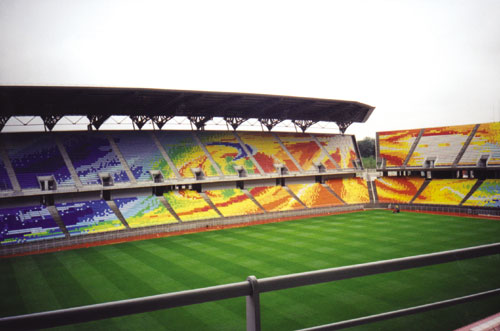Hosting a major sporting event is a goal for any city. On Dec. 29, 1997, Suwon, South Korea, scored when it was chosen as one of 10 South Korean cities to host the 2002 FIFA World Cup™ Korea Japan (Japan co-hosted the event). Suwon fought to win the bid because it believed the games would help make it recognized internationally as a world-class city of culture.
To make the games successful and prepare Suwon for visitors, the city planned many construction projects and embarked on its largest investment project since being founded in the 18th century. Central to the project was constructing the Suwon World Cup Stadium. SAMSUNG Engineering Co. Ltd., Seoul, South Korea, was named the stadium's builder, and Hallim Precision, Seoul, was asked to submit a bid for the roof system. Holyoke, Mass.-based Stevens Roofing Systems, a longtime provider of roofing materials in Asian markets, was asked by Hallim Precision to help prepare specifications for the stadium.
Stevens Roofing Systems specified a light-colored TPO membrane roof system. Because Suwon officials wanted to address environmental and heat-reduction issues, Stevens Roofing Systems and Hallim Precision were chosen to install the 250,000-square-foot (22500-m²) roof system.
Suwon
Suwon, which is 29 miles (46 km) from Seoul and has about 1 million residents, is the center city of Gyeonggi-do Province in the Metropolitan Zone of Capital City. Suwon is Korea's first planned city; King Jeongjo the Great of the Joseon Dynasty scientifically formed the city to appease the spirit of his father, who was murdered by Jeongjo's grandfather. Jeongjo moved his father's tomb to the hills of the Hwasan Mountains in Suwon because the mountains were the most propitious site according to geomantic principles.
In 1794, in an attempt to reach filial piety and political reform, Jeongjo began building the Suwon Hwasong Fortress where royalty ruled, lived and protected refugees. Jeongjo hoped the move would enable Suwon to replace Seoul as the capital city. Hwasong Fortress, which was built by 70,000 workers in 28 months, is the first fortress built with western technologies, and its protective walls measure 19,147 feet (5744 m).
Now, 238 years later, Suwon is known as an agricultural and horticultural city but quickly is growing technologically thanks, in part, to SAMSUNG Electronics and other technological companies that have established themselves there. Suwon, which recently changed its motto to "Suwon—a city where happiness and harmony exist," is said to be Korea's leader in technological and economical development.
Stadium
Winning the World Cup bid was a major step toward Suwon becoming recognized internationally. To help reach this goal, Suwon officials created plans for the stadium that would allow the city to thrive after the World Cup games left town.

Photo courtesy of Stevens Roofing Systems, Holyoke, Mass.
The stadium's roof symbolizes a bird's soaring wings.
For example, the stadium is home to the Samsung Suwon Bluewings professional soccer team. In addition, features were included in the arena that could be used by residents, other teams and tourists year-round. The arena features an auxiliary stadium; three practice fields; sports facilities, such as a swimming pool and tennis courts; and recreational facilities, such as cinemas, concert halls, restaurants, retail stores and fashion-show catwalks.
The 343,767-square-foot (30939-m²) stadium sits on about 4.7 million square feet (42500 m²) of land and has a 44,047-seat capacity. When planning the stadium, designers wanted audiences to feel the games' energetic atmospheres and see players' movements better than they could in other stadiums. As a result, the stadium is dominated by multimedia functions and well-planned lighting and seating arrangements.

Photo courtesy of Stevens Roofing Systems, Holyoke, Mass.
The stadium was designed to make the audience feel soccer games' energetic atmosphere.
The stadium's aesthetic design is based on the Suwon Hwasong Fortress. The wing-shaped roof, which features typical Korean architectural characteristics that create harmony with surrounding landscapes, shades the two long sides of the oval-shaped stadium. The roof symbolizes a colossal bird's soaring wings and Suwon's desire for greater things. The roof covers 58 percent of the stadium's seats.
Installation
To complete the project in the specified four months, Hallim Precision used two 10-member crews—one crew per roof section. Roof system installation occurred during winter 2001, which forced Hallim Precision's crews to work in uncommonly cold weather.
Because crew members worked about five stories in the air, extensive safety precautions were taken. For instance, fences were installed around the roof's perimeter; scaffolding used to access the roof was surrounded by safety nets; and workers wore safety harnesses that were attached to safety rails. In addition, all workers wore hardhats and gloves.
Installation began by mechanically attaching 2 inches (51 mm) of polyisocyanurate insulation to the stadium's 20-gauge steel deck. Stevens' 60-mil- (0.06-inch- [1.5-mm-]) thick Light Slate Gray EP™ TPO membrane then was mechanically attached. The TPO membrane was chosen not only for its energy-efficient qualities but also because it adapts to unusual shapes and is easy to install and maintain. Finally, Preassembled Stevens XHD Fasteners were installed. The roof system has an FM Research 1-135 windstorm classification rating.
Vincent McPartland, vice president of international sales and marketing for Stevens Roofing Systems, believes the TPO membrane's characteristics were demonstrated during the winter installation and game time.
"Stadium and city officials were impressed with how easily the Stevens EP was installed. And … soccer fans [enjoyed] World Cup action in a venue that [is] markedly cooler than one with a darker roof surface," McPartland says.
Future
Suwon's officials hope the city's quest for recognition will be realized. But Stevens Roofing Systems knows it is recognized every time a game is played at the Suwon World Cup Stadium. For Stevens Roofing Systems, it is rewarding the project was completed on time and showcased to the world.
Kate Gawlik is associate editor of Professional Roofing magazine.
